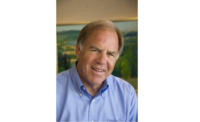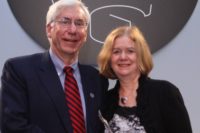
Gary Rogers: Feelin’ Groovy
When T. Gary Rogers and W.F. Cronk bought Dreyer’s Grand Ice Cream for $500,000 in 1977, they didn’t exactly know what the future would bring.
“When we bought this little company, it was
doing $6 million in sales,” recalls Rogers, who’s retiring as
CEO at the end of the year. “We didn’t have an explicit
mission, but if we did, maybe it was to someday expand the reach of
Dreyer’s throughout the West. Our goal was to be the leading Western
ice cream manufacturer.”
Though at the time Dreyer’s did little business
outside the San Francisco Bay area, Rogers says becoming best in the West
wasn’t as daunting as it sounds. The ice cream industry then was
composed of many regional milk processors that made ice cream as an
incremental business.
So by 1981, Dreyer’s reached that first goal,
and the company went public with a value of $45 million.
The next goal was to become the leader in the national
market, of which Dreyer’s had about a 4 percent share. Breyers, the
national leader at the time with dominance on the East Coast, had about 10
percent.
So through steady expansion, and launching Grand Light
along the way, Dreyer’s passed Breyers in 1994. The new
Dreyer’s goal, Rogers says, was then to become the
“pre-eminent” ice cream company in the country, encompassing
all formats.
That battle continues. In 1994, Kraft Foods sold
Breyers to Unilever, which “has proved a much tougher
competitor,” Rogers says. “It’s been a real
dogfight.”
Dreyer’s and Unilever each have about 25 percent
market share, Rogers says. “The industry over the last 30 years has
gone from a regional industry into one that’s becoming an
oligopoly,” he says. “Both of us have come from almost no share
30 years ago.”
Rogers envisions the future of the ice cream industry
like the beverage industry with Coke and Pepsi — two major companies
dominating the national market, surrounded by niche players. “The
charge now is to complete the mission,” he says. “Current
momentum suggests it’s in the cards.”
But Rogers will be content to watch that happen from
the sidelines. “I’ve been here for 30 years and it
wouldn’t be fair to the successor team to have my shadow on this
company,” he says. “It’s time to let the new team find
their way.”
Rogers, who returned from an overseas vacation shortly
before this interview, will keep busy with his position as deputy chairman
of the San Francisco Federal Reserve Bank, as well as other projects
he’s not yet at liberty to divulge.
“I have great joy and pride,” he says,
“in having been a steward of this company for 30 years.”

